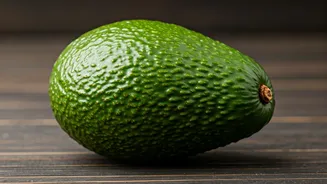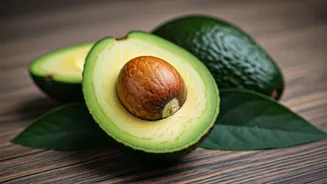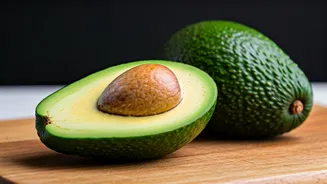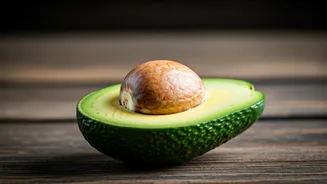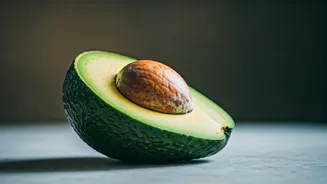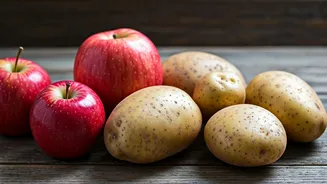Inspect the Skin
The first step in choosing a ripe avocado is a thorough visual inspection. The skin color offers a valuable clue. Most avocados transition from green to
a darker hue as they ripen. However, this varies among varieties. For instance, Hass avocados change from green to dark green or even purplish-black. Other types remain green even when ripe. Therefore, knowing the variety can assist in determining ripeness through color. Look for avocados with consistent skin color, avoiding those with bruises, blemishes, or indentations, as they may indicate internal damage. These can affect the fruit's quality and taste. The skin texture is also crucial. Ripe avocados typically have a slightly bumpy texture, while unripe ones often feel smoother.
The Pressure Test
A gentle squeeze reveals much about an avocado's ripeness. Apply gentle pressure with your palm or fingers to the avocado. It should yield slightly to the pressure without feeling overly soft or mushy. A firm avocado is unripe, while one that gives too easily is likely overripe. The ideal ripeness provides a balance – soft enough to indicate readiness, but firm enough to retain its shape. The pressure test allows an assessment of the avocado's internal texture, providing a final verification of the fruit's ripeness. Avoid avocados with any indentations; this means the fruit has likely been dropped. This test can be used to purchase avocados, and it can also be used to track ripening at home, as the fruit can soften over a period of days.
Check the Stem
The stem area, where the avocado was connected to the tree, is another reliable indicator of ripeness. Gently remove the stem. If it comes off easily, the avocado is likely ripe. Underneath the stem, observe the color. If it is green, the avocado is at its peak. A brown color suggests it is overripe. A light green or yellow color signifies it may still be ripening. The stem also helps determine the avocado's freshness. A firmly attached stem could mean the avocado was recently picked. If the stem is missing or has a moldy appearance, it suggests the fruit has been mishandled or is past its prime. This simple check provides a final confirmation of ripeness, ensuring the avocado is perfect for your culinary creations.
Variety Matters
Different avocado varieties ripen differently, so understanding the specific type is important. Hass avocados, the most common variety, turn from green to dark green or black when ripe. Other varieties, like Fuerte, may remain green. Learning about the avocado type helps in making the right choices. Color is not always the best indicator. In some varieties, the texture of the skin may also indicate ripeness. For instance, the skin of a ripe Hass avocado often has a slightly bumpy texture. Consider this in your selection process. Educating yourself about each variety's characteristics ensures better results. This knowledge empowers consumers to confidently pick the best avocados, regardless of the type or appearance, and to fully enjoy the rich flavor and texture.
Storage Solutions
Improper storage can impact an avocado's ripening process. Unripe avocados should be stored at room temperature to allow ripening. Placing them near fruits like bananas or apples can accelerate the process because these fruits release ethylene gas, a natural ripening agent. Once ripe, store avocados in the refrigerator to slow down further ripening. This can extend their shelf life by several days. If you only use half an avocado, save the remaining half by leaving the pit in, adding a squeeze of lemon or lime juice to prevent browning, and wrapping it tightly in plastic wrap or placing it in an airtight container in the fridge. This conserves the fresh taste and prevents it from turning brown. Proper storage techniques are crucial for maximizing the shelf life of the avocado and maintaining its quality.
